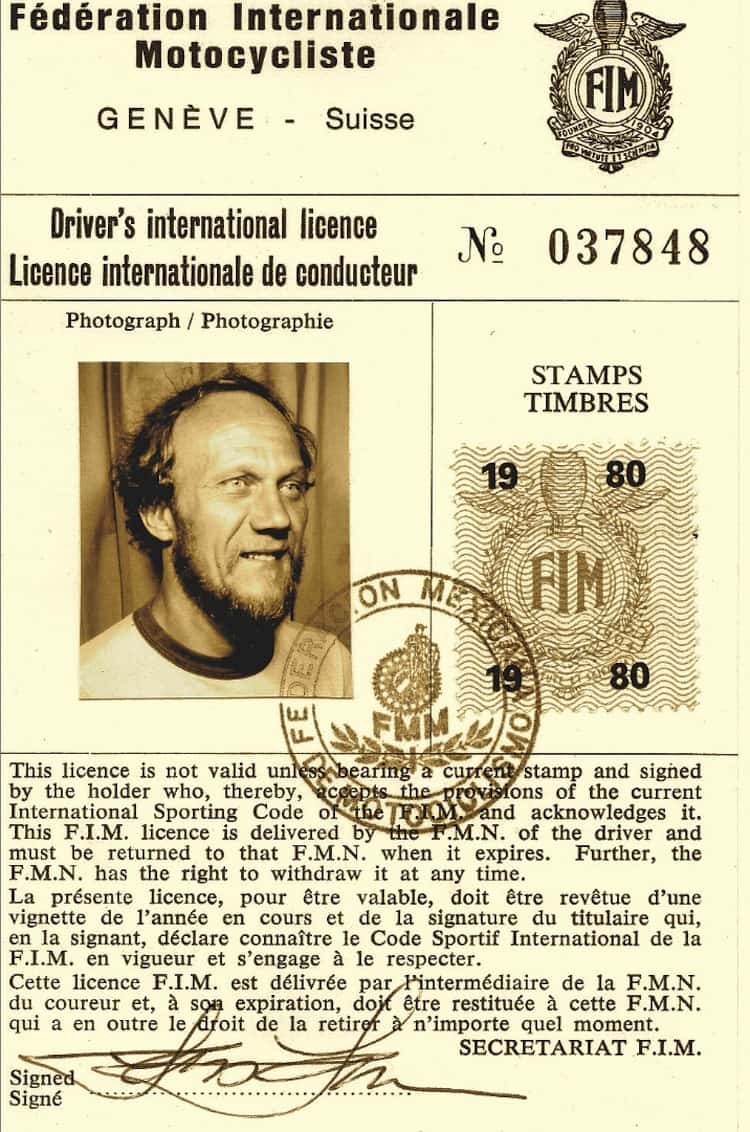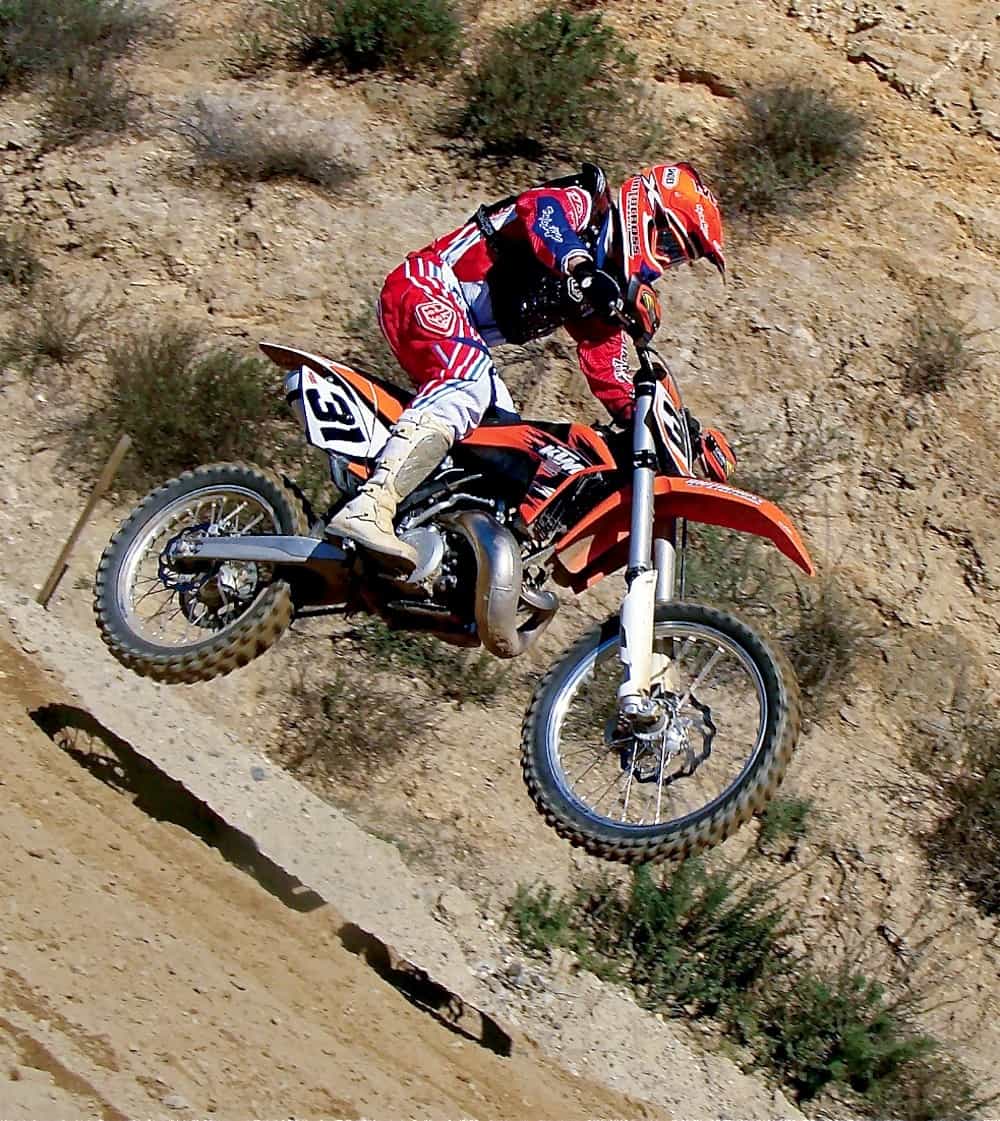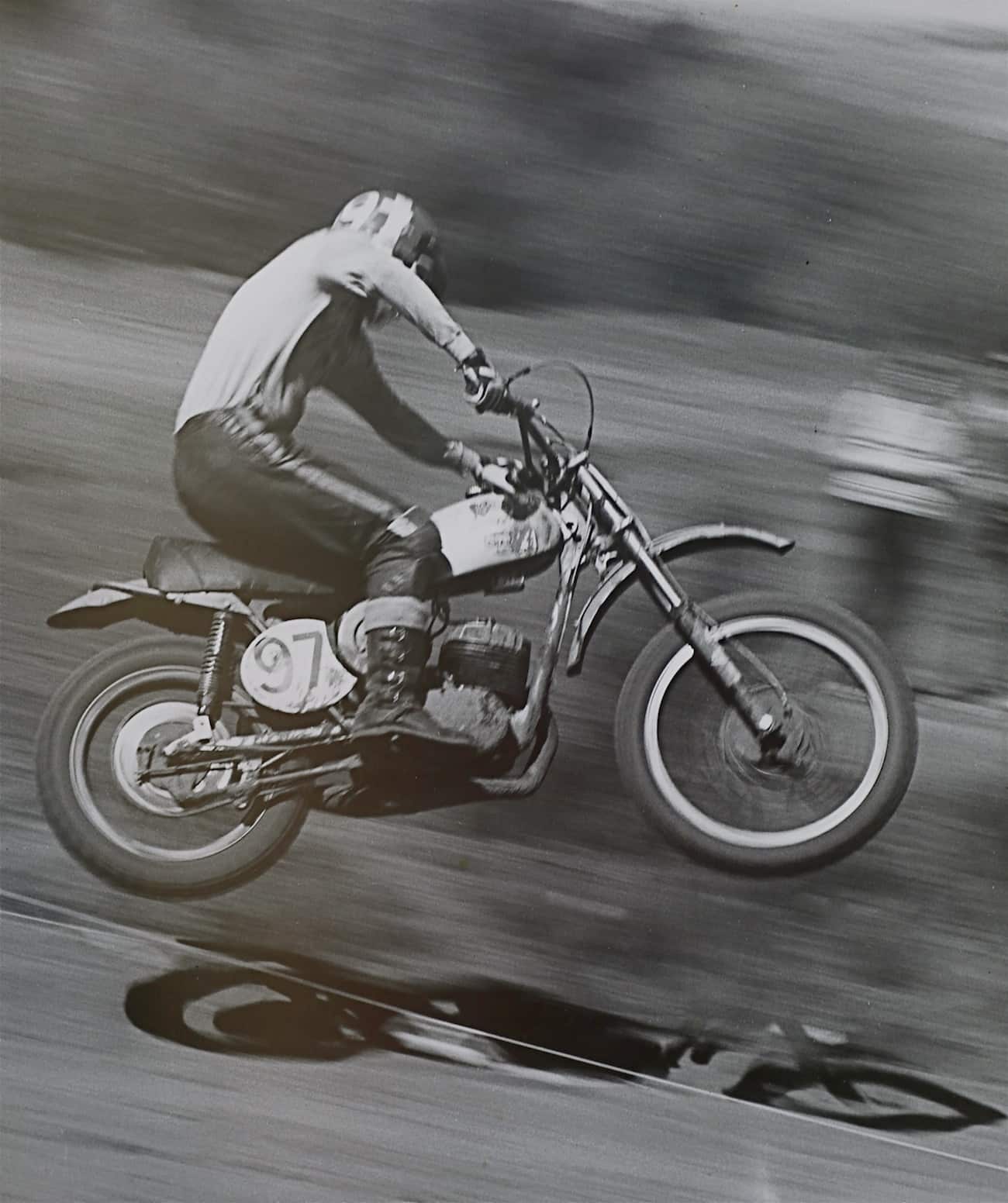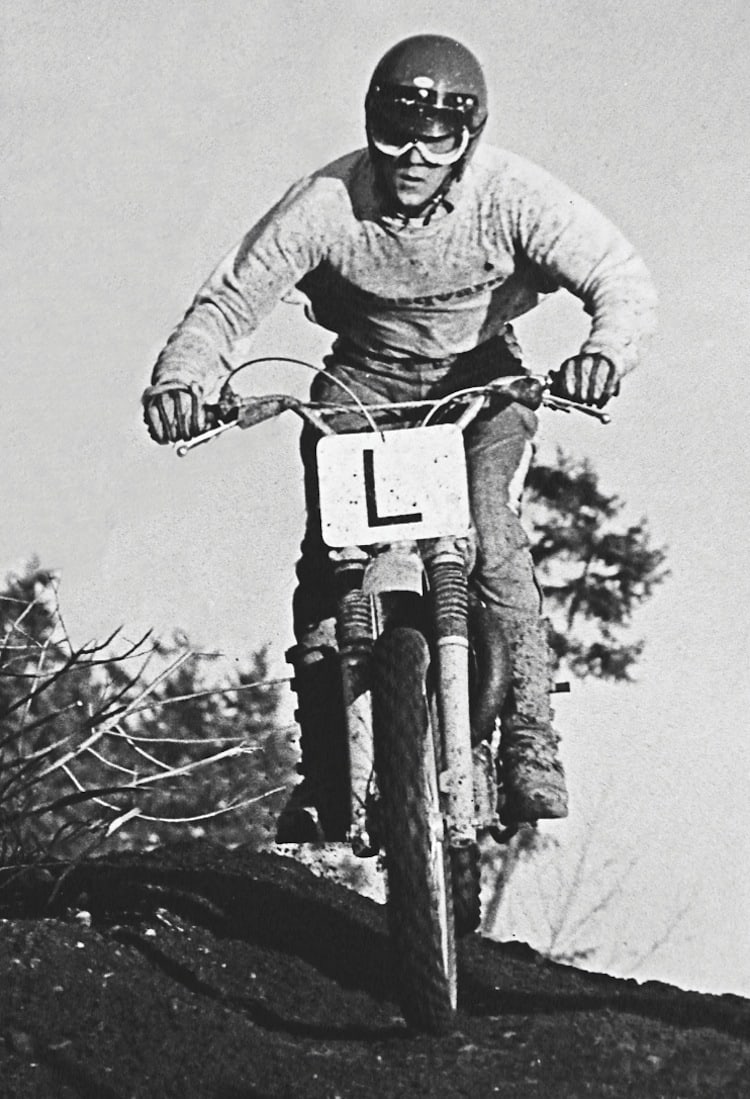LARS LARSSON INTERVIEW: THE MAN WHO DISCOVERED AMERICAN MOTOCROSS
 Hakan Andersson (left), Torsten Hallman, Christer Hammargren, Arne Kring, Bengt Aberg, Lars Larsson and Gunnar Lindstrom were the power elite in 1971.
Hakan Andersson (left), Torsten Hallman, Christer Hammargren, Arne Kring, Bengt Aberg, Lars Larsson and Gunnar Lindstrom were the power elite in 1971.
By Jean Turner
YOU WERE THE FIRST GRAND PRIX RACER TO MOVE TO AMERICA. HOW DID THAT COME ABOUT? At first I didn’t know anything about Husqvarna’s plans. My buddies kept telling me, “Hey, I heard you’re going to America.” I didn’t know what they were talking about, so I asked where they heard that rumor. They said, “Torsten Hallman told us.” So, at the next round of the Swedish Championship, I walked up to Torsten and said, “Excuse me, but they’re saying that I’m going to America.” Torsten looked shocked and said, “Oh my, I guess I forgot to tell you!”
TORSTEN HAD COME TO THE USA EARLIER THAT YEAR? Torsten had come to America in 1966, and Husqvarna importer Edison Dye had asked Torsten if he knew somebody that would come to the United States to represent the brand. Torsten suggested me. Eventually, Husqvarna asked me if I was interested and I said, “Oh, sure.” I met Edison Dye, Rubin Helmin and Bror Jauren at a fancy restaurant just north of Husqvarna and signed a one-year contract. They said that I would go straight to America after being on the Swedish Trophy Team at the 1966 ISDT in Poland. In the time between our meeting and the ISDT, they put me in the factory for a couple weeks to teach me everything about servicing Husqvarnas. Then, when I was in Poland, Edison Dye came up to me and said, “Hello, Lars. Here’s the key. There’s the car. Take it to Brussels and fly to Chicago. I’ll meet you there.” I said, “Okay.” I thought Chicago was a suburb of San Diego [laughs]. That proved to be wrong.

Lars autograph sheet when he was a factory Husqvarna racer.
TELL US ABOUT YOUR FIRST RACE IN AMERICA? Edison Dye picked me up and he said, “We’re going to go racing. We’re going to the Indiana State TT Championship.” I didn’t know what a TT was. At the race I signed up as “Larry Lawson,” because under FIM rules I couldn’t take part in any racing that wasn’t sanctioned by the FIM. My Husky was still in its crate, and when we pulled this Swedish two-stroke with Trelleborg knobbies on it out, people gathered around to look at it. People had never seen knobby tires at a dirt-track race. They said, “Hey, what is that? What are you doing? You won’t stand a chance with those kind of tires. You need dirt-track tires.” Edison told them, “Oh, it’s okay. This is called a motocross bike, and we just want him to ride it to show what it can do.” I whipped them with those tires, and after the race the fans gathered around to talk to me, but I didn’t speak English. All I could say was: “Husqvarna … very good-quality Swedish … very good motorcycle.” Edison repeated this story many times over the years, and he always laughed, because the spectators shook their heads and said, “Them California boys sure talk funny.”
AT THE TIME, WERE YOU THE ONLY MOTOCROSS RACER IN THE COUNTRY? Oh, absolutely. The people had never seen a motocross race or an actual motocross bike. I went around to many dealers and many places. One night outside Kansas City I saw an airplane up in the air, and I just started bawling; I was so homesick I cried. But, I overcame that.
DID THE AMERICANS KNOW ANYTHING ABOUT MOTOCROSS? It was funny, because many of the dealerships said, “Hey, come back Saturday. We’ll teach you how to ride a motorcycle. We have an enduro.” I just came to America directly from racing the International Six Day Trials and they were going to show me how to ride in the woods. The guy who won the race was docked 12 points for being late. I was docked 28 points because I was too early to every checkpoint. At every check they would say, ‘You gotta slow down! You gotta slow down!” And finally I asked, “You want me to walk and push the bike?” In some towns, after I beat them, they took the trophies away from me. They didn’t like factory riders coming to their town and “stealing our boys’ trophies.”
 Lars at his AMA Hall of Fame induction.
Lars at his AMA Hall of Fame induction.
WHAT WAS YOUR JOB FOR EDISON DYE? My job was to sell Husqvarna motorcycles to dealers. I would travel from city to city, win races and sign up dealers. The first town I went to was Dayton, Ohio. When I got there, I ripped a page out of the phone book and drove to the first motorcycle shop in the yellow pages. The first bikes I sold were to Competition Accessories in Xenia, Ohio. They had a mom-and-pop shop in the basement of their house. They came out to look at the bike. They had never heard of a Husqvarna, but it started on the first kick. And they went, “What?” Back then, no motorcycle started on the first kick! I went across the road to a big grass field and popped some wheelies and roosted dirt all over the place. They bought three bikes. They were the first Husqvarna dealership in America.
 Lars was the West Coast Penton distributor. As before, Lars sold bikes by winning races on them. Note the Hallman visor, chest protector, leathers, gloves, boots and prototype Lexan face protector.
Lars was the West Coast Penton distributor. As before, Lars sold bikes by winning races on them. Note the Hallman visor, chest protector, leathers, gloves, boots and prototype Lexan face protector.
HOW DID THOR GET STARTED? I only had a one year contract with Husqvarna, but during that year I realized that the American riders didn’t have any motocross equipment. They didn’t have boots. They didn’t have leathers. They didn’t have gloves. I told Torsten Hallman, “Hey, we should sell stuff over here.” I don’t think we would have ever opened Torsten Hallman Offroad Racing (THOR) if it weren’t for John Penton. I met John in Daytona and told him our plans. He said, “If you open a business, I’ll send you a container of Penton motorcycles.” Just like that we became the West Coast distributor of Penton Motorcycles. We opened the doors in August of 1968, and, just like with Husqvarna, I was back on the road selling Penton motorcycles. My English was a little better now, but the Penton deal kept the doors open when we first started to import products. In my mind, I thought, ‘We can’t make a living selling motocross pants, boots and gloves. Who could do that?” That was the start of some fantastic years.
 Lars raced the ISDT for three different Trophy teams—Sweden, United States and Mexico. He was also on the Kawasaki factory ISDT team (above).
Lars raced the ISDT for three different Trophy teams—Sweden, United States and Mexico. He was also on the Kawasaki factory ISDT team (above).
IS IT TRUE THAT YOU FORMED THE MEXICAN ISDT TEAM SO YOU COULD RACE? The reason Team Mexico came about is that they held some enduros down there, and I convinced them to form an ISDT team with the approval of the Mexican federation.
 Lars in 1966, joking around for the camera at the Tilf campground just outside of Liege, Belgium. That was the place where lots of 1960 Grand Prix riders stayed between races in Europe. That is Lars’ Mercedes Benz taxi that he bought to tow a trailer to the races.
Lars in 1966, joking around for the camera at the Tilf campground just outside of Liege, Belgium. That was the place where lots of 1960 Grand Prix riders stayed between races in Europe. That is Lars’ Mercedes Benz taxi that he bought to tow a trailer to the races.
WERE THERE ANY MEXICAN RIDERS ON THE TEAM? No. The team was Fred Cameron from San Francisco, Jim Simmonds from Missouri and myself. That year’s ISDT was in Sweden. They had an opening ceremony where the teams marched down the main street holding their national flags just like the Olympics. When our turn came, we marched in wearing big sombreros, and I could hear the Swedish kids standing on the curb saying, “They don’t look any different from us.” I’m the only rider in the world who has been on three trophy teams for three different nations—Sweden, America and Mexico.
 Lars Larsson’s 1980 FIM Pro license.
Lars Larsson’s 1980 FIM Pro license.
WHAT MADE HUSQVARNA THE DOMINANT BIKE IN THE 1960s AND 1970s? Two people—Bror Jauren and Ruben Helmin. They were very enthusiastic about racing, and if it hadn’t been for them, I don’t think Husqvarna would have ever made a dirt bike. They basically built the first Husky motocross bikes without the approval of the big shots. Husqvarna made a little street bike called the Silverpilen 175, and Bror and Rubin modified it for racing. They were lucky to get people like Torsten Hallman to ride it. He beat everybody. But, it is because of Bror and Rubin that Husqvarna decided to build motocross bikes. They had the vision. There are many people like that; Henry Ford would be one. He had a passion. It’s that spirit that is the driving force.

Lars Larsson is a four-time World Vet Champion— 2001 Over-60 Expert champion and 2011-2012 Over-70 Expert champion and the 2021 Over-80 champion.
WHAT LED TO HUSQVARNA’S DECLINE? Electrolux. They didn’t have the spirit. They would rather sell lawnmowers and refrigerators. They bought Husqvarna and then sold it to the Italians. Husqvarna belongs to Sweden, just like Volvo. The workers at the Husky factory never got over it. They broke away and started up Husaberg. They did it because of their pride and the Swedish way of thinking, and against all odds they won the 500 World Championships. Today, under KTM ownership, Husqvarna is a proud brand once again—not Swedish, but close.
 Lars Larsson flying the fabled titanium Husky during the 1971 Inter-AMA series.
Lars Larsson flying the fabled titanium Husky during the 1971 Inter-AMA series.
TELL US ABOUT THE FABLED TITANIUM HUSKY? The summer with the titanium bike was something else. A salesman came to us and said, “Hey, I’m in the titanium business. I think there should be a bike made with titanium.” Pro Fab in Orange County built the frame. It was so light. You took the start and never looked back. You were gone! It was a fantastic bike to ride, and we were very successful on that bike. In 1971 I won four of the five Inter-Am 500cc support races on it. It was so successful that the AMA outlawed it. They blamed it on the cost, but you can never convince me of anything like that. The AMA banned what they didn’t understand. They stood in the way of innovation.
 Lars’ titanium Husqvarna was banned by the AMA after the 1971 season and now resides in a museum.
Lars’ titanium Husqvarna was banned by the AMA after the 1971 season and now resides in a museum.
WHAT DO YOU LIKE ABOUT MODERN MOTOCROSS? Supercross. What a success that was. It’s a different sport. I know many of the old riders don’t think much of it, but it’s a fantastic extension of motocross. To have been a small part of the sport’s evolution is a fantastic thing. I’ve seen the changes from the first time an American came to Europe to compete to Team USA dominating the Motocross des Nations 22 times. The whole thing has been an unbelievable experience. It’s like you dropped something in the water and the ripples grew bigger and bigger. It’s nice to sit with a little glass of wine and think, yea, I was a little part of that.
WHAT DO YOU THINK OF THE LUONGO ERA OF GP RACING? I think that the World Championships don’t mean squat today in the sense that everybody is not welcome to compete. In the old days, each country was allowed to send riders to compete in the World Championship. That is not the case today. Each country’s best should be allowed to see where they stand against another country’s best riders. To me, in many ways, the AMA Nationals are the real World Championship today. They are open to anyone from anywhere. But, at the same time, the AMA Nationals are not really the World Championships. Where I come from, a World Champion has to compete around the world. He’s gotta eat the food they give him, listen to the language they speak and adapt to the weather they have. I wish there were more Americans competing in the World Championship. The biggest honor you can have is to represent your country. As a sportsman, as a rider, there is no higher calling.
 80-year-old Lars Larsson on this way to the 2021 Over-80 World Vet Championship. It was Lars’ fourth World Vet crown. Amazingly, he won the Over-60 crown in 2001, his first Over-70 title in 2011 (and repeated again in 2012) and won the Over-80 Championship in 2021—we expect big things out of him in 2031 when he turns 90. When ask about the number 13 on his Husqvarna FC450, he said, “That’s the day I met my wife, so it’s a lucky number.”
80-year-old Lars Larsson on this way to the 2021 Over-80 World Vet Championship. It was Lars’ fourth World Vet crown. Amazingly, he won the Over-60 crown in 2001, his first Over-70 title in 2011 (and repeated again in 2012) and won the Over-80 Championship in 2021—we expect big things out of him in 2031 when he turns 90. When ask about the number 13 on his Husqvarna FC450, he said, “That’s the day I met my wife, so it’s a lucky number.”
YOU ARE STILL RACING AT 80 YEARS OLD. WHAT IS THE COMPETITION LIKE? Well, it doesn’t pay as well as the Pro class did. I’ve raced for 60 years, and there are moments when I know that I hit a corner really well. At the same time, I realize I’m going extremely slow. I still love to ride motorcycles, and the camaraderie of racing is very special. I’m honored to have been a part of the MXA wrecking crew for decades. I get to ride different bikes every week. Jody Weisel and I can still have our battles on the track. I can’t see myself in a sailboat, and I don’t like to golf. Motocross is it for me. Those kids who are just turning 60, they’re hard to deal with!







Comments are closed.